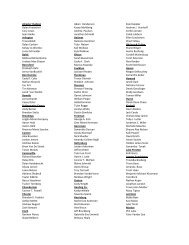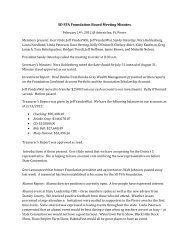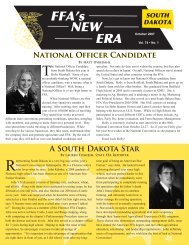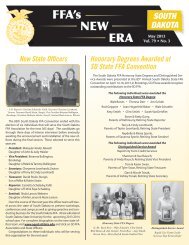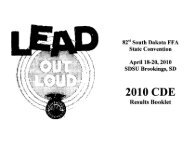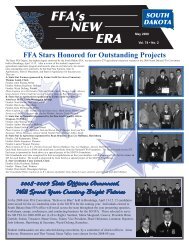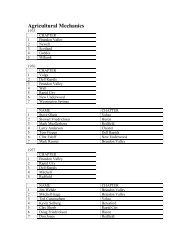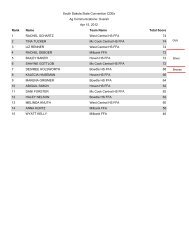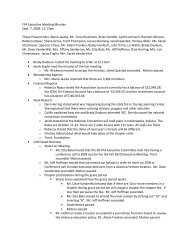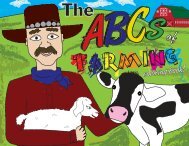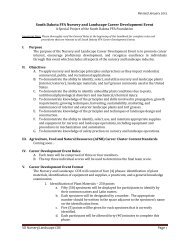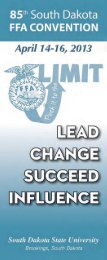South Dakota FFA Horse Evaluation CDE Test April 11, 2011 1 ...
South Dakota FFA Horse Evaluation CDE Test April 11, 2011 1 ...
South Dakota FFA Horse Evaluation CDE Test April 11, 2011 1 ...
You also want an ePaper? Increase the reach of your titles
YUMPU automatically turns print PDFs into web optimized ePapers that Google loves.
<strong>South</strong> <strong>Dakota</strong> <strong>FFA</strong><br />
<strong>Horse</strong> <strong>Evaluation</strong> <strong>CDE</strong> <strong>Test</strong><br />
<strong>April</strong> <strong>11</strong>, 20<strong>11</strong><br />
1. What part of the horse’s digestive tract is the primary site for water absorption?<br />
a. Colon<br />
b. Cecum<br />
c. Small intestine<br />
d. rectum<br />
2. Night blindness or or poor vision during the twilight hours may be due to a deficiency in which<br />
vitamin?<br />
a. Vitamin A<br />
b. Vitamin B<br />
c. Vitamin C<br />
d. Vitamin D<br />
3. How many bones make up the skeleton of the horse?<br />
a. 200<br />
b. 205<br />
c. 210<br />
d. 215<br />
4. What is the common name for the disease, Equine Encephalomyelitis?<br />
a. Influenza<br />
b. Equine Herpes virus<br />
c. Swamp Fever<br />
d. Sleeping Sickness<br />
5. What structure lies between the sole and the wall of the hoof?<br />
a. Laminae<br />
b. White line<br />
c. Navicular bone<br />
d. Pedal pone<br />
6. What is the largest joint in a horse?<br />
a. Carpus<br />
b. Hock<br />
c. Fetlock<br />
d. Stifle<br />
7. Permanent intermediate incisors erupt at:<br />
a. 4-6 weeks<br />
b. 6-9 months<br />
c. 2-2.5 years<br />
d. 3-3.5 years
8. Which hormone is produced by the follicle of a mare prior to ovulation, and causes her to<br />
display interest in the stallion?<br />
a. Oxytocin<br />
b. Progesterone<br />
c. Prolactin<br />
d. Estrogen<br />
9. The fraudulent act of making a horse appear younger than it actually is by altering teeth is:<br />
a. Sculpting<br />
b. Floating<br />
c. Bishoping<br />
d. Blacksmithing<br />
10. In regards to reproduction, horses are:<br />
a. Seasonally polytoccus<br />
b. Seasonally polyestrous<br />
c. Biannually polytoccus<br />
d. Biannually polyestrous<br />
<strong>11</strong>. Which of the following horse behaviors is a nuisance habit?<br />
a. Weaving<br />
b. Cribbing<br />
c. Kicking<br />
d. Biting<br />
12. Which of the following essential elements in a horse’s diet is a macromineral?<br />
a. Iodine<br />
b. Phosphorus<br />
c. Copper<br />
d. Iron<br />
13. Each horse has how many pairs of chromosomes?<br />
a. 32<br />
b. 34<br />
c. 36<br />
d. 38<br />
14. Blister beetles produce a poisonous secretion called:<br />
a. Endophyte<br />
b. Prussic acid<br />
c. Selenium<br />
d. Cantharidin<br />
15. Which of the following groups of horses are likely to need a higher plane of nutrition than the<br />
others?<br />
a. Geldings doing moderate work<br />
b. Mares in early lactation<br />
c. Mares in late gestation<br />
d. Stallions doing light work<br />
16. Immunity acquired from mare to foal through colostrum is what type of immunity?<br />
a. Active<br />
b. Passive<br />
c. Disruptive<br />
d. Incomplete
17. An imperfection that affects the horse’s value, but not its serviceability is called what?<br />
a. Unsoundness<br />
b. Eye Sore<br />
c. Blemish<br />
d. Fracture<br />
18. Ringworm is caused by:<br />
a. Fungi<br />
b. Worms<br />
c. Bacteria<br />
d. Virus<br />
19. How many hands tall is a 60 inch horse?<br />
a. 15 hands<br />
b. 15.5 hands<br />
c. 16 hands<br />
d. 16.5 hands<br />
20. Which of the following are most commonly used on the hind hooves of reining horses?<br />
a. Half-round shoes<br />
b. Weighted shoes<br />
c. Sliding plates<br />
d. Heel calks



